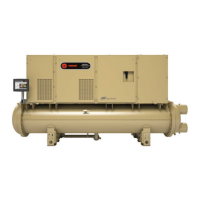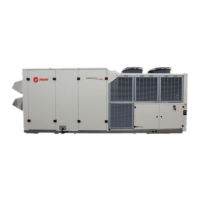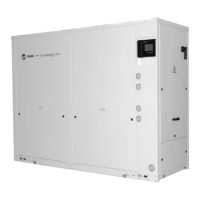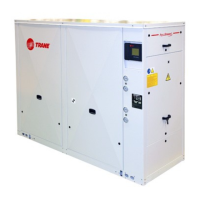70
AC-SVX003A-EN
Field-supplied contacts for all low voltage connections must
be compatible with dry circuit 24 VDC for a 12 mA resistive
load. Refer to the field diagrams that are shipped with the
unit.
External Circuit Lockout – Circuit #1 and
#2
The unit controller provides for an auxiliary input of a
customer specified or installed contact closure, for
individual inhibition of the operation of either or both
circuits. If the contact is closed, the respective refrigerant
circuit will not operate.
Upon contact opening, the respective refrigerant circuit will
run normally. This feature is used to restrict total chiller
operation, e.g. during emergency generator operations.
Connections to External Circuit Lockout Inputs LLID inputs
are shown in the field diagrams that are shipped with the
unit.
These customer-supplied contact closures must be
compatible with 24 VDC, 12 mA resistive load. Silver or
gold plated contacts are recommended
Ice Building Option
The unit controller provides auxiliary control for a customer
specified/installed contact closure for ice building if so
configured and enabled. This output is known as the Ice
Building Status Relay. The normally open contact will be
closed when ice building is in progress and open when ice
building has been normally terminated either through Ice
Termination setpoint being reached or removal of the Ice
Building command. This output is for use with the ice
storage system equipment or controls (provided by others)
to signal the system changes required as the chiller mode
changes from “ice building” to “ice complete”. When Ice
Making Control contact is provided, the chiller will run
normally when the contact is open.
The unit controller will accept either an isolated contact
closure (External Ice Building command) or a Remote
Communicated input (Tracer®) to initiate and command the
Ice Building mode.
The unit controller also provides a “Front Panel Ice
Termination Setpoint”, settable through Tracer® TU, and
adjustable from 20 to 31°F (-6.7 to -0.5°C) in at least 1°F
(1°C) increments.
Note: When in the ice building mode, and the evaporator
entering water temperature drops below the ice
termination setpoint, the chiller terminates the ice
building mode and changes to the ice building
complete mode.
NOTICE
Equipment Damage!
Failure to follow instructions could result in damage
to system components.
Freeze inhibitor must be adequate for the leaving
water temperature.
Tracer® TU must also be used to enable or disable Ice
Machine Control. This setting does not prevent the Tracer®
from commanding Ice Building mode.
Upon contact closure, the unit controller will initiate an ice
building mode, in which the unit runs fully loaded at all
times. Ice building shall be terminated either by opening
the contact or based on the entering evaporator water
temperature. The unit controller will not permit the ice
building mode to be reentered until the unit has been
switched out of ice building mode (open Ice Making Control
contacts) and then switched back into ice building mode
(close Ice Making Control contacts.)
In ice building, all limits (freeze avoidance, evaporator,
condenser, current) will be ignored. All safeties will be
enforced.
If, while in ice building mode, the unit gets down to the
freeze stat setting (water or refrigerant), the unit will shut
down on a manually resettable diagnostic, just as in normal
operation.
Connect leads from customer supplied 7S6 to J2-3/4 on
1KF34. Refer to the field diagrams which are shipped with
the unit.
Silver or gold-plated contacts are recommended. These
customer furnished contacts must be compatible with 24
VDC, 12 mA resistive load.
External Chilled Water Setpoint (ECWS)
Option
The unit controller provides inputs that accept either 4-20
mA or 2-10 VDC signals to set the external chilled water
setpoint (ECWS). This is not a reset function. The input
defines the setpoint. This input is primarily used with
generic building automation systems (BAS). The chilled
water setpoint set via the Tracer® AdaptiView™ TD7 or
through digital communication. The arbitration of the
various chilled water setpoint sources is described in the
flow charts at the end of the section.
The chilled water setpoint may be changed from a remote
location by sending either a 2-10 VDC or 4-20 mA signal to
the External Demand Limit and Chilled Water Setpoint
Inputs LLID board, terminals 5 and 6 LLID. 2-10 VDC and
4-20 mA each correspond to a 10 to 65°F (-12 to 18°C)
external chilled water setpoint.
The following equations apply:
Voltage Signal
As generated from external
source
VDC=0.1455*(ECWS) + 0.5454
As processed by controller ECWS=6.875*(VDC) - 3.75
Current Signal
As generated from external
source
mA=0.2909(ECWS) + 1.0909
As processed by controller ECWS=3.4375(mA) - 3.75
Installation Electrical
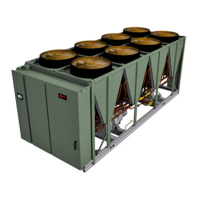
